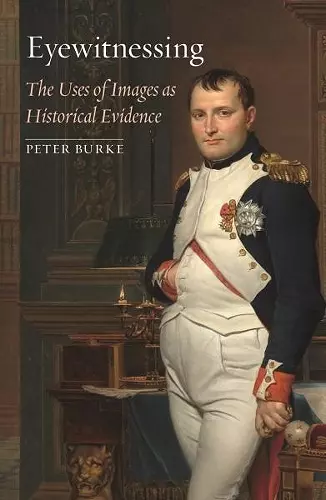Eyewitnessing
The Uses of Images as Historical Evidence
Format:Paperback
Publisher:Reaktion Books
Published:12th Aug '19
Should be back in stock very soon

Eyewitnessing evaluates the place of images among other kinds of historical evidence. By reviewing the many varieties of images by region, period and medium, and looking at the pragmatic uses of images (e.g. the Bayeux Tapestry, an engraving of a printing press, a reconstruction of a building), Peter Burke sheds light on our assumption that these practical uses are ‘reflections’ of specific historical meanings and influences. He also shows how this assumption can be problematic.
Traditional art historians have depended on two types of analysis when dealing with visual imagery: iconography and iconology. Burke describes and evaluates these approaches, concluding that they are insufficient. Focusing instead on the medium as message and on the social contexts and uses of images, he discusses both religious images and political ones, also looking at images in advertising and as commodities.
Ultimately, Burke’s purpose is to show how iconographic and post-iconographic methods – psychoanalysis, semiotics, viewer response, deconstruction – are both useful and problematic to contemporary historians.
Provides us with a compendium . . . which continues the long process of restoring the balance between written documentation and optical representation as carriers of historical information . . . a thoroughly engrossing explication of how fine art, graphics, photographs, film and other media can be used to make sense of lives lived out in other times * Tate Magazine *
Well-informed and fair-minded, and it prompts one to ponder * Michael Baxandall, English Historical Review *
Eyewitnessing is not about the value of images at all, but rather about the primacy of words . . . The book becomes a sustained argument for the preservation of old-fashioned text-based history, through the constant citing of contexts in which images are nothing without textual support. * Nicholas Hiley, Times Literary Supplement *
Burke . . . describes and evaluates the methods by which art historians have traditionally analyzed images, finding them insufficient to address the complexities of visual imagery. * Book News *
Burke . . . has produced a fine book resulting from his study of images as sources of historical evidence. . . .The author . . . is known for his interest in finding links between languages, cultures, and epochs as well as methodologies and disciplines. The present volume is an example of this sweeping intelligence at work and is a must for students of history, culture, fine arts, anthropology, and film. * Choice *
This book is especially valuable for its many examples of images that could be used in historical research, and for its coherent summary of key concepts and theories . . . Eyewitnessing is highly recommended for historians and art historians alike. * Nina K. Stephenson, University of New Mexico, Art Documentation *
Any timid historian reading this book would run in terror from even thinking about using images as evidence. Burke details the pitfalls as he surveys types of images historians might use . . . Overall, an encouraging short introduction to a tricky subject. * Virginia Quarterly Review *
As Peter Burke illustrates in Eyewitnessing, images have a long tradition of distorting the facts. Of what use, then, are images to scholars of history? What types of historical evidence do images provide? Burke sets out to answer these questions. His book is intended to encourage and instruct readers in the historiographic use of images, and it succeeds splendidly on both counts . . . Through an impressive array of case studies, Burke demonstrates the value of images to historians while providing instructive warnings about their use . . . For those new to the study of images, Eyewitnessing provides an accessible and practical introduction to the historiographic use of visual culture. For art historians and scholars already committed to the study of visual phenomena, Burkes book serves as a cogent reminder of the complex relations between images and history * Sharon Corwin, University of California, Berkeley, Technology and Culture *
ISBN: 9781789140613
Dimensions: unknown
Weight: unknown
280 pages